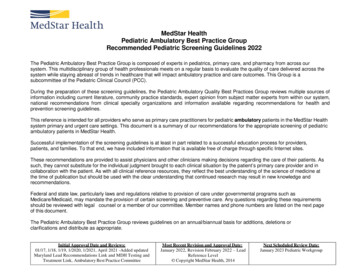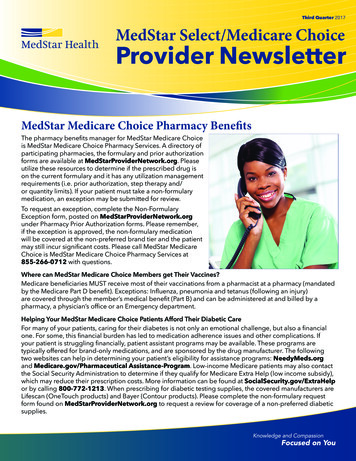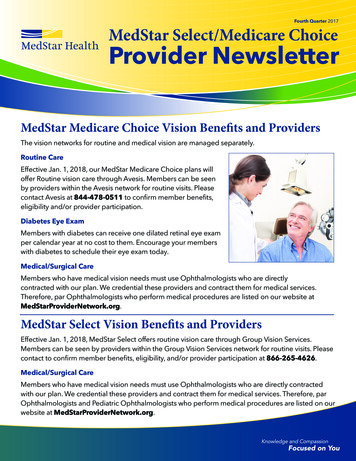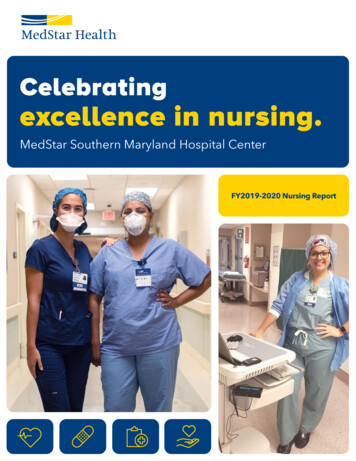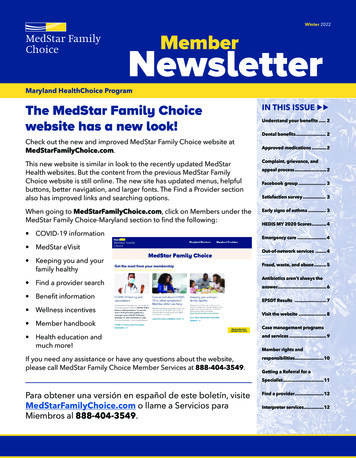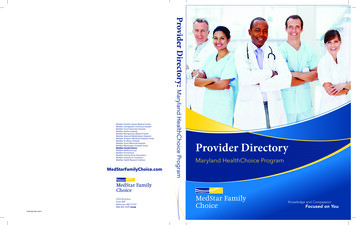
Transcription
Vision, Mission and ValuesOur VisionTo be a trusted leader in caring for people and advancing health.Our MissionWe are Good Samaritans, guided by Catholic tradition and trusted to deliver ideal healthcare experiences.Our SPIRIT Values Service: We strive to anticipate and meet the needs of our patients, physicians, and fellow Good Samaritans. Patient First: We strive to deliver the best to every patient every day. The patient is the priority in everything we do. Integrity: We communicate openly and honestly, build trust, and conduct ourselves according to the highest ethicalstandards. Respect: We treat each individual, those we serve, and those with whom we work with the highest professionalismand dignity. Innovation: We embrace change and work to improve all we do in a fiscally responsible manner. Teamwork: System effectiveness is built on the collective strength and cultural diversity of everyone, working withopen communication and mutual respect.Ethical and Religious Directives Shaping our MissionMedStar Good Samaritan Hospital, founded as a Catholic hospital in 1968, follows the Ethical and Religious Directives forCatholic Health Care Services as outlined by the United States Conference of Catholic Bishops. These directives guide theethical and moral issues facing Catholic health care in accordance with the Church’s teaching on the dignity of all persons.The Ethical and Religious Directives address six main areas: The Social Responsibility of Catholic Health Care Services The Pastoral and Spiritual Responsibility of Catholic Health Care The Professional-Patient Relationship Issues in Care for the Beginning of Life Issues in Care for the Seriously Ill and Dying Forming New Partnerships with Health Care Organizations and ProvidersThe Ethical and Religious Directives for Catholic Health Care Services may be found on the United States Conferenceof Catholic Bishops’ website: USCCB.org.PATIENT ADMITTING AND INFORMATION HANDBOOK1
Table of ContentsWelcome from the President. 3Your Stay in the Hospital. 4 About Your Room.4– Bed Controls.4– Call Lights.4– Clinical Equipment Alarms.4– Housekeeping.4 During Your Stay.5– Fall Prevention.6– Fall Risk Assessment.7– Gown.8– Identification Bracelet.8– Medications.8– Pain Management.8– Patient Meals.10– Personal Items.10– Rapid Response Team.10– Safe Lifting.11– Speak Up.11– Tests.12 Your Room Amenities. 12– Internet.12– Mail Delivery.12– Newspapers.13– Radio.13– Telephone.13– Important Phone Numbers.13– Television.14– C.A.R.E Channel.14– TV Channel Programming Guide.14Patient Information and Services. 15 Admitting and Registration. 15 Blood Donation. 15 Case Management and Social Work. 15 Concerns and Questions. 15 Financial Responsibilities. 16 Good Health Center. 16 Interpreter Services.17– Deaf and Hard of Hearing.17– Language Interpreter.17 Medical Records.17 Notary Public.17 Patient Care Advisory Committee.17 Patient Experience Survey.17 Patient Information. 182 Patient Portal(Online Access to Your Health Information). 18 Pharmacy. 18– Bedside Delivery Prior to Discharge.18 Private Duty Nurses. 18 Rehabilitation Services. 19 Taxi Services. 19Healthcare Decisions and Advance Directives. 20 You Have the Right to Decide AboutYour Healthcare. 20 Naming a Healthcare Agent. 20 Using Advance Directives. 20 What Happens If You Do Not Make an AdvanceDirective?. 20 Preparing an Advance Directive. 21 How Do You Get More Information?. 21Visitor Information. 22 Accommodations for Guests. 22 Healthcare Support Person. 22 Visiting Hours. 22 Visitor Guidelines. 23Hospital Information. 24 ATM (Automated Teller Machine). 24 Auxiliary. 24– Gift Shop.24– Thrift Shop.24 Book Cart. 24 Food Service for Guests and Visitors. 24 Healthcare Team Recognitions. 25 Parking. 25 Pastoral Care and Spiritual Support. 26 Philanthropy. 26 Security Services . 26 Volunteer Services. 26Hospital Policies and Guidelines. 27 Alcoholic Beverages. 27 Cell Phone/Smart Phone andAudio/Video Guidelines. 27 Fire Safety. 28 Infection Prevention. 28 Patient Rights and Responsibilities. 28 Privacy Issues. 30 Smoking Policy. 30Notice of Nondiscrimination. 31
Welcome from the PresidentWelcome to MedStar Good Samaritan Hospital. We are committed to providing you withquality, safe, compassionate care throughout your stay with us. Our doctors, nurses, clinical staff,and our associates are all focused on you. This dedication to our patients is what drives us toprovide extraordinary patient experiences and is rooted in our Catholic heritage—from offeringan environment of healing with respect and dignity for all to providing innovative treatmentsand services.Our community has trusted their health needs to MedStar Good Samaritan Hospital for 50 yearsand we are paving the way to continue our legacy well into the future. The Ethical and ReligiousDirectives for Catholic Health Care are guiding principles for the care provided at MedStarGood Samaritan Hospital. In addition, as part of MedStar Health, we are developing andimplementing ways our community can have the best access to excellent health care.We look forward to caring for you. If you have any questions, please do not hesitate to ask. We want you to be comfortableand to understand the medical care you are receiving. Thank you for entrusting us with your care.In good health,Bradley S. ChambersPresident, MedStar Good Samaritan HospitalPresident, MedStar Union Memorial HospitalSenior Vice President, MedStar HealthPATIENT ADMITTING AND INFORMATION HANDBOOK3
Your Stay in the HospitalAt MedStar Good Samaritan Hospital, we want our patients to be as comfortable as possible while they are staying with us.The following section provides information about your room, what to expect during your stay, and the various amenitiesavailable to help make your stay more pleasant.ABOUT YOUR ROOMAll patient rooms are either semi-private (two patients per room) or private (one patient per room). Requests for privaterooms will be honored as available. The following information explains important features about your room.Bed ControlsThe buttons to control your bed are located on both bed rails. To raise the head of your bed, press the “up” arrow withthe picture of a head on it and to lower the head of your bed, press the “down” arrow with the picture of the head on it.To raise the foot of your bed, press the “up” arrow with the picture of the foot on it and to lower the foot of the bed,press the “down” arrow with the picture of the foot on it.Call LightsYou may call one of your caregivers for assistance at any time by using your call light. Bed Call Light: Your call light is located on the side rail of the bed (it has a picture of a nurse on the button). If you have ahandheld call light, simply press the big red button to alert your nurse. If you are experiencing pain and need your nurse,please use the green button with the frown face on it. This message will be sent directly to your nurse. If you need to usethe bathroom, please use the yellow button with the toilet picture on it. This message will be sent directly to your careassociate. For all other requests, please use the red button and your message will be sent to the nurse’s station. Bathroom Call Light: The bathroom call light can be found on the wall next to the toilet. Simply pull the string and thecall light will alert your care team.Clinical Equipment AlarmsWhile in the hospital, you may be required to have continuous monitoring (heart rate, blood pressure, vital signs,oxygen saturation, IV pumps, etc.). The equipment is set to certain parameters to alert the nursing staff of possiblechanges in your status; however, most of these alarms are not an emergency. Please do not touch the equipment.Tampering may interfere with the nurse’s ability to provide necessary care. Please use your call light to notifyyour nurse.HousekeepingOur Housekeeping staff will provide you with excellent care by keeping your room and the patient care unit cleanand tidy. Your housekeeper completely cleans and disinfects your room before you arrive. Housekeepers cleanpatient rooms daily between 7 a.m. and 3:30 p.m. They will remove trash from your room twice, early and late inthe day. Table surfaces, chairs, and heating units will be wiped off, walls spot washed, television dusted, and thefloor dusted and wet mopped. Restroom cleaning includes disinfecting the toilet, sink, mirror, spot-wiping walls,filling dispensers, and dry/wet mopping floors. Any spills or other housekeeping issues should be reported toyour nurse as they happen so Housekeeping can be notified immediately.4
DURING YOUR STAYAs patients are the most important members of the healthcare team, we encourage them and their loved ones to activelyparticipate in their recovery. Our care team is committed to providing safe, high-quality care, wrapped in exceptional service.Here are just some of the very important members of your healthcare team: Medical Staff: Our doctors, residents, and physician assistants are dedicated to working together to ensure you receivethe most advanced medical treatment in the most caring environment. Your Doctor: Often called your attending physician, your personal doctor diagnoses and treats your medical conditionin addition to communicating daily with the rest of the staff to devise your optimal plan of treatment. Residents: These doctors are receiving education under the supervision of our attending doctors. Physician Assistant (PA): A PA answers questions for surgical patients during pre-admission testing and, upon admission,provides pre-operative and post-operative care for medical and surgical patients, and assists the attending physicianswith patient care. They provide coverage with the physicians and help manage your care during your hospital stay. Registered Nurse (RN): We use a Nursing Care Delivery Model, called Contemporary Primary Nursing, to optimize yourexperience and to help your nurse get to know you better. You will be assigned a Primary Nurse who will care for youuntil your discharge. Your Primary Nurse and your physician will work closely together to plan your day, plan your stay,and jointly communicate with you and your family. In coordinating your care plan, your Primary Nurse will work with youto consider what is important to you as well as coordinate your discharge plan and services for when you go home.In addition, Associate Nurses may be assigned to support and provide continuity for your care when your Primary Nurseis off duty. Your Associate Nurse will coordinate all care with your Primary Nurse. Multifunction Technician: This specialized technician provides direct care when you are in specific areas of the hospitalincluding the emergency room, intensive care, short stay, or post-anesthesia care units. Certified Nursing Assistant (CNA) or Geriatric Nursing Assistant (GNA): Under the direct supervision of nurses,CNAs and/or GNAs provide basic nursing care to patients. Patient Care Associate (PCA): The PCA provides direct bedside care under the supervision of the RN. To help you inyour recovery, he or she will make every effort to ensure that you are comfortable. Integrated Specialists for Respiratory Therapy and Pharmacy: Integrated specialists are available to provide carefor you, as needed, in their fields of medical expertise. With your doctor’s consent, they offer treatments that willsupport your recovery. U nit Secretary: The unit secretary will serve as your communications liaison. He or she will answer your call lightand handle much of the routine paperwork. He or she will try to make your stay with us as comfortable as possible.Every day we look for ways to be attentive and responsive to our patients, their families, and visitors. We want you toknow that we put you first and strive to deliver the MedStar Health Way—excellence in patient care. To help us achievethis, your physician and nurse participate in the following patient care practices: Bedside Shift Change and Report: When the nurse team changes shift they give an update to the nurse coming onduty about your care. They will give this report in your room with you and you are encouraged to participate in thisdiscussion and be a partner in your care. This is a good time to ask questions and meet the nurse coming on shift.You also can invite a family member or friend to take part in this discussion. Bedside shift report occurs every daybetween 7 and 7:30 a.m. and again between 7 and 7:30 p.m. Multi-Disciplinary/Plan of Day Rounding: Multi-disciplinary rounding brings all the key caregivers together to offertheir clinical expertise in coordinating patient care, determining care priorities and daily goals, and planning fordischarge. The multi-disciplinary team includes residents, attending physicians, nurses, and case managers/socialworkers, and can include pharmacists, nutritionists, physical therapists, respiratory therapists, and facility staff.The team is an innovative approach in patient care, communications, and quality. White Boards: The dry erase boards in each patient room help physicians and nurses makeimportant notes on your care. These boards also are available to you to list familymember names or add information that you want your caregivers to see.PATIENT ADMITTING AND INFORMATION HANDBOOK5
Fall PreventionWe try to do everything we can to create a safe environment while you are in the hospital. Safety is our number one concern.MedStar Good Samaritan Hospital has identified some things that can help keep you safe and help prevent falls: Call for help or use your call light when getting out of bed or going to the bathroom. Make sure you can reach the things you need—glasses, cane, walker, phone, tissue, water, call light, etc. Wear slippers with nonslip soles. Sit or stand up slowly. Let someone know if you are dizzy or light-headed. Report spills or hazardous conditions to your care team. Do NOT hesitate to call for assistance. We are here to help.While you are in the hospital, there are many things that mayput you at risk for falling. These include: New medications with possible side effects Unfamiliar surroundings More time in bed Less sleep Depression Fear and the stress of being separated from familyand friendsIf you fall: Try to remain calm. Call out for help. If possible, use the call light to alert thenursing staff. Do not try to get up; you may be hurt.Stay where you are and wait for helpto arrive.6
Fall Risk AssessmentWe use the Morse Fall Risk Assessment to identify your risk for falling:MORSE FALL RISK ASSESSMENTRisk FactorScaleScoreHistory of er15None/Bed al/Bed Rest/Immobile0Forgets Limitations15Oriented to Own Ability0Secondary DiagnosisAmbulatory AidIV/Heparin LockGait/TransferringMental StatusTotal of All Risk FactorsTo obtain the Morse Fall Risk Score, add the score from each individual category.Morse Fall Risk: High Fall Risk 45 or higherIf you are identified as being at high risk for a fall, we will use several interventions to attempt to prevent you from fallingduring your hospital admission, including: Yellow wrist bands Yellow, nonskid slippers Signage Bed set to the lowest position Bed and chair alarms Upper bed railsWe strongly recommend your cooperation with all of these fall interventions, as we care about your health and safety.In addition, family and friends can help keep you safe by keeping the area around your bed clutter free, especially thepath to the bathroom or bedside toilet.Please remember: You must call for assistance when you need to get out of bed.PATIENT ADMITTING AND INFORMATION HANDBOOK7
GownA hospital gown is required for all patients so our caregivers can easily examine and provide care to you. In most cases,if preferable, you may wear a robe that opens in the front.Identification BraceletTo ensure your safety, be sure to wear your hospital identification bracelet during your entire visit. If you receive a coloredbracelet, wear it as well.MedicationsThe Inpatient Pharmacy provides all the medications required during your stay in the hospital. The choice of drug dosageis based on your physician’s evaluation of your condition. The inpatient pharmacists work with your physician to make sureyou are on the best medication regimen possible. Some drugs are best administered by nurses to ensure that yourphysician’s directions for dosage and timing are followed.Be sure to notify your caregivers about any medications you currently are taking or recently have taken. This will help ourhospital staff understand the status of your health.Our hospital offers a self-medication training program, which is designed to help you learn to take your medicationscorrectly. If you and your physician decide that this program is appropriate, you will take your medications undernursing supervision.Do not take any medication without the knowledge and approval of your physician or nurse. If you have any questionsor concerns about your medications, you may ask your nurse for a pharmacy consultation.Pain ManagementYour doctors and nurses will help prevent and relieve pain. When your pain is controlled, you can prevent needlessdiscomfort as well as: Heal faster and feel better sooner Start walking and doing your breathing exercises so you can get your strength back faster Improve your results and avoid problems (such as pneumonia, blood clots and stress)Pain Management OptionsMedication and nonmedication treatments can be helpful in preventing and controlling pain. You and your doctorsand nurses should decide which methods are best for you.Medication MethodsPain medications can be given in many ways, including: Oral: Pain medications are taken by mouth in pill or liquid form. Injection: Shot of medication is given with a needle into a muscle. Transdermal: Skin patches containing pain medication are applied to the skin and used for long-term pain management. PCA (Patient Controlled Analgesia) Pump: The patient can control pain by pushing a button. The pump then safelydelivers small doses of pain medication through an intravenous (IV) tube in a vein. C atheter: Small tube placed in the back by the anesthesiologist and connected to a PCA pump that delivers painmedication and allows the patient to give extra doses, when needed.8
Nonmedication Methods Heat and cold packs Positioning Splinting of an incision Relaxation Massage Prayer and positive thinking Distraction technique (such as listening to music, watching TV, reading, or visiting)Communicating Your PainWe ask that you help the nurses and doctors measure your pain. You will be asked routinely to rate your pain on ascale of 0 to 10 (0 no pain; 10 worst pain imaginable). Or you may choose a face from the scale below that bestdescribes your pain. You also will be asked if you are experiencing any side effects. Reporting your pain helps yourcare team determine if your treatment is working and whether to make changes.INSERT FACES HEREIt’s Important that You Report Uncontrolled Pain Don’t worry about being a bother. Pain can be a sign of problems. The nurses and doctors want and needto know about it. Don’t automatically assume you need less painmedication because your pain is under control.Be Sure to: Talk with your nurses and doctors about:– Pain control methods that have worked well ornot so well for you in the past– Any concerns you may have about pain medicationand ask questions– Any allergies or reactions to medications you havehad in the past Take your pain medication or ask the nurse forpain medication:– When the pain starts. This is a key step in properpain control.– Prior to getting out of bed, walking or doingbreathing exercises. It is harder to ease painonce it has taken hold. Let your doctors and nurses know if you areexperiencing any problems such as itching,nausea, dizziness or if you just don’t feel right.PATIENT ADMITTING AND INFORMATION HANDBOOK9
Patient MealsFood Services offers menu options based on the diet your physician has ordered. Restricted diets may be ordered for certainmedical conditions and can limit the types of food available, how foods are prepared and food portions.Each day, a Catering to You associate will bring you a menu so you can select your meal choices. Remember to includebeverage choice and condiments, such as butter, margarine, salad dressing, cream, and sugar, when you order your meals.If needed, a dietitian is available to speak with you; just ask your nurse to request a consultation.Approximate meal times: Breakfast: 8 a.m. Lunch: 12:45 p.m. Dinner: 5:45 p.m.Personal Items We provide you with a toothbrush, toothpaste, mouthwash, skin care lotion, soap, and tissues. We ask that you leave large sums of money, keys, jewelry, personal papers, medicines, and other valuables at home.If you brought them with you, please send them home with a friend or family member. Keep only small amounts ofmoney for personal purchases. If you do have personal valuables that need to be secured, please notify your caregiver, who then will notify Security. Please be aware that you are responsible for personal items, such as dentures, eyeglasses, hearing aids, and prosthetics,so be sure to store them in a safe place. Remember, leaving dentures on your tray table or food tray may increase thechance they are mistaken for trash and accidentally discarded. To be safe, leave them in the drawer of your nightstand. The hospital is not responsible for lost or stolen personal items.Rapid Response TeamWe want you to be involved in your own care and take an active role in your treatment. One of the most important timesto do this is when you feel your condition is rapidly getting worse and/or you feel like you’re having a medical emergency.Symptoms of a medical emergency include: Racing heartbeat Feeling of impending doom Sudden numbness and weaknesson one side of the body New chest pain Excessive nausea/vomiting Sudden and excessive sweating New shortness of breath10
During these situations, MedStar Good Samaritan Hospital’s Rapid Response Team is available to help 24 hours a day,seven days a week. Our Rapid Response Team is comprised of critical care specialists who will be at your bedside withinminutes to provide immediate care. The team’s goal is to prevent a medical emergency, such as a heart attack or stroke,before it happens.If you feel a medical emergency is about to occur or if your symptoms are rapidly getting worse, do not hesitate torequest the Rapid Response Team. To do so, immediately call your nurse or charge nurse on the unit. He or she willquickly assess your condition and, if necessary, call the Rapid Response Team.Safe LiftingAt MedStar Good Samaritan Hospital, we want to keep you safe and comfortable. In order to help ensure maximumsafety and quality of care during your stay, we have established a safe lifting and repositioning program. Patient selfmobility and independence are encouraged whenever practical. Manual lifting of patients is discouraged in all situationsexcept medical emergencies or life-threatening situations. While at our hospital, you may be assisted with mobility bythe use of safe lifting equipment.SPEAK UP: Help Prevent Errors in Your Care—A Message from The Joint Commission (TJC)Everyone has a role in making healthcare safe—physicians, healthcare administrators, nurses, and technicians.You, as the patient, also can play a vital role in making your care safe by becoming an active, involved, and informedmember of your healthcare team.The SPEAK UP program, sponsored by The Joint Commission (TJC), urges patients to get involved in their care.This initiative provides advice on how you can make your care a positive experience. Research shows that patientswho take part in decisions about their care are more likely to have better outcomes.Speak up if you have questions or concerns, and if you don’t understand, ask again. It’s your body, and you have a rightto know. Your health is too important to worry about being embarrassed if you don’t understand something that your doctor,nurse, or other healthcare professional tells you. Don’t be afraid to tell the nurse or doctor if you think you are about to receive the wrong medication.Pay attention to the care you are receiving. Make sure you’re getting the right treatments and medications by the righthealthcare professionals. E xpect healthcare workers to introduce themselves when they enter your room, and look for their identification badges. Notice whether your caregivers have washed their hands. Don’t be afraid to gently remind a doctor or nurse to do this;it prevents the spread of infection.Educate yourself about your diagnosis, the medical tests you are undergoing, and your treatment plan. Gather information about your condition. Good sources include your doctor, your library, respected websitesand support groups. Write down important facts your doctor tells you so you can look for additional information later. Thoroughly read all medical forms and make sure you understand them before you sign anything. If you don’t understand,ask your doctor or nurse to explain them. Make su
Vision, Mission and Values. Our Vision. To be a trusted leader in caring for people and advancing health. . MedStar Good Samaritan Hospital, founded as a Catholic hospital in 1968, follows the Ethical and Religious Directives for . and jointly communicate with you and your family. In coordinating your care plan, your Primary Nurse will work .
